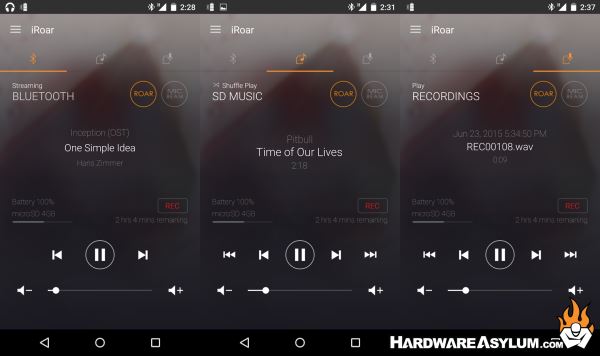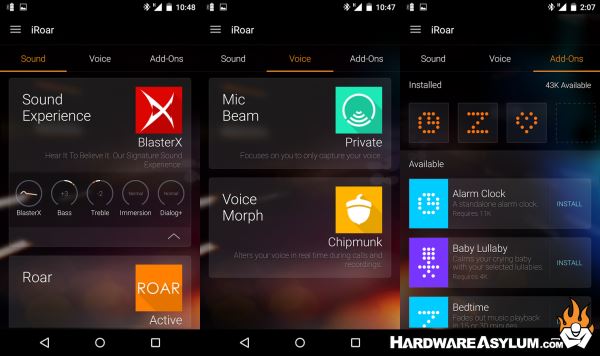Creative Labs iRoar Bluetooth Speaker Review
Author: Darren McCainCreative iRoar Application Support
No discussion about the Creative iRoar would be complete without delving in to the application and developer support. Right out of the box the iRoar is supported by a set of companion applications the iRoar Dashboard and the iRoar Remote Assistant. I should also note you can create your own add-ons with the iRoar Software Development Kit (SDK) already available from Creative. I installed both applications on my Samsung Galaxy S5 using the latest Marshmallow build.
I should note here I tested the iRoar for several days before I installed the applications across my PC and the Amazon Dot. When I installed the software on my phone it immediately prompted me with a firmware update to the iRoar which I accepted bringing my iRoar to V 1.33.01 (48452382).
The Creative iRoar Remote Assistant application is a wireless remote control for the iRoar on your compatible phone. I found this particularly helpful when I was testing across different devices thanks to all the additional visual information. As I continue to use the iRoar I am sure I will gravitate towards the on device controls as I get used to seeing them.

Most of the functionality in the iRoar Remote Assistant is spread across the three tabs shown here. All three screens provide device information like battery level, SD card capacity when installed estimated up time remaining and access to the Roar and MIC Beam functions.
The Bluetooth tab provides functionality for your paired Bluetooth device. When streaming to the iRoar this screen will provide details on the track you are streaming as shown here. The iRoar is compatible with most common audio formats such as MP3, AAC and WAV. (MP3 format up to 320kbps,AAC format up to 320kbps and VBR). This will also allow you to access music stored on your device such as a SD card on your phone.
The middle tab is for the SD card controls. To use this feature you will need a microSD or microSDHC cards up to 32GB formatted in FAT/FAT32. I should note that you can get this same basic functionality (Shuffle or Loop) directly on the iRoar when installed.
The third tab is for Recordings. This is where you can manage and playback any recordings stored on the iRoar’s SD card and works in the same manner.
The Creative iRoar Dashboard application acts as a home for the iRoar applications and comes with several preinstalled to match your device. It looks like there is a hard limit of 8 additional applications at this time. I can’t tell if this is linked to the SD card capacity but it does leave the possibility if additional storage via firmware updates.
With the iRoar Dashboard installed I found the Remote Assistant application now stored in the dropdown menu alongside the iRoar MegaPhone application. The iRoar Megaphone application must be installed separately and allows you to access the voice changing features through your phone. This application supports the optional iRoar Mic sold separately. Both can be accessed at the top right side of the Dashboard.

Like the iRoar Remote Assistant the iRoar Dashboard splits functionality across three major sections.
The Sound Tab is the key that unlocks most of the iRoar’ audio magic. Functionality is divided into three additional sections: The Sound Experience lets you choose from one of 6 preconfigured and professionally tuned configurations based on your content. Your choices are BlasterX, Live Concert, Audiophile Bliss, Game On, Sonic Bass and Cinemania. Choosing a profile applies a preset equalizer, adjusts the iRoar Immersion and Dialog+ boost. Creative has partnered with multi-award winning artist Wyclef Jean for the iRoar and I would love to see some custom profiles around this sort of partnership in the future!
Roar simply applies the built in sound boost to increase loudness and depth. The application suggests this for large parties and social gatherings but I found it equally useful listening to music at lower volumes as it kept the bass presence without needing to up the volume for background listening. As I write this review I am streaming some light trance music at a low volume via Amazon Music!
The Voice Tab is the home of two different functions; Mic Beam and Voice Morph. Mic Beam changes the recording between a 360° Omnidirectional recording mode designed for conference calling style captures to a Private mode that focuses only on one voice for crisp recording or hands free calling. Voice Morph gives access to 18 different voice modification profiles each with a simple icon. I am not a big fan of voice morphing but there is a lot here to play with if that’s your thing.
Add-Ons Provide access to any additional applications you might want to download to your SD card. A SD card is required but functions like Alarm Clock, Bedtime countdown and Nature sounds are great additions and can be loaded onto the iRoar for direct access each with a unique LED pattern to aid on device navigation. There is great potential for additional third party add-ons though all the most common bases are covered.

